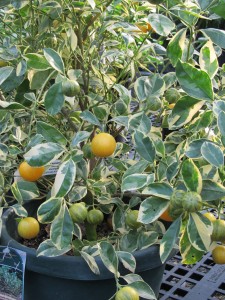Calamondin orange (Citris mitis) is challenging to grow in a home environment. It is hardy to 20°F., more than most other true citrus (USDA hardiness zone 8). It does not grow well in temperatures below 45ºF.
In temperate regions calamondin spends the active growing months (May – October) outdoors either in direct sunlight (in northern areas) and in half day shade (in south). Calamondin is moved indoors in winter into a well lit room.
New plants may be easily started from seeds or as rooted cuttings. Flowers are self-fertile and require no cross-pollination. A plant can be forced to flush new growth and bloom by withholding water. Once the leaves show symptoms of wilting, water the plant thoroughly. It should recover full of fragrant blooms within two months.
All citrus plants require iron supplement when soil pH creeps into the alkaline range. Iron becomes less available when soil becomes less acidic. A key symptom of iron deficiency is yellowing of the upper (newest) leaves. Twice yearly, use an iron supplement to maintain healthy green foliage. An alternative is to feed with a water-soluble acidic fertilizer such as Peters™ 20-10-20, Miracle-Gro™, or Schultz™.
Sticky or web-covered leaves may be signs of mite, mealy bugs, and scale infestations. Aphids and white fly may be problem pests in spring. Mealy bugs can be managed with insecticidal soaps inside the home. Otherwise, take the plant outdoors and spray with a pesticide labeled for controlling the specific insect on house plants.
Under optimum growing conditions, annual growth rate is 1 foot per year. Calamondin produces an abundant fruit crop starting at two years of age or when plants are at least 18-24 inches tall. Fruits are usually harvested in the fall.
Calamondin fruits have a thin, smooth, yellow to yellow-orange peel that is easily separable. Ripen fruits are very astringent, but make a tasty marmalade spread for your morning bagel or toast.


 Posted in
Posted in 
